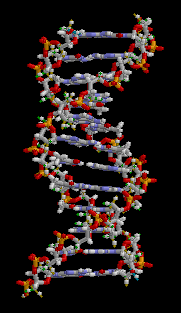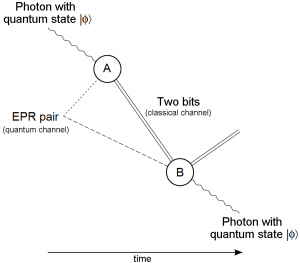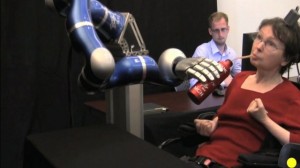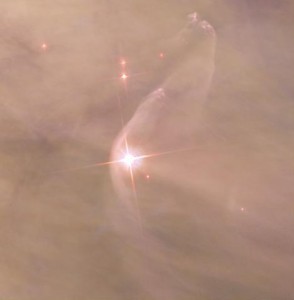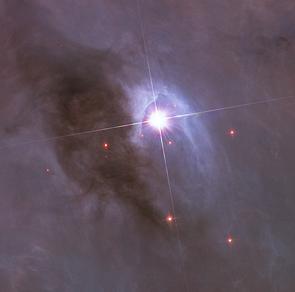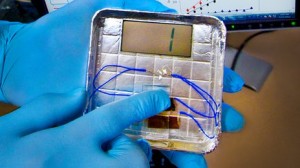Archive for the ‘Science News’ Category
DNA Computing – Helix Memory Storage
I don’t think many people have any idea how far we’ve come. Because I like to keep track of scientific and technological developments as part of writing science fiction, I have a better idea than most, but then a story like this one comes across my desktop and I’m left in disbelief.
It has only been sixty years since the structure of DNA was understood, and now researchers at Stanford University have figured out how to write, read, and rewrite bits of information on DNA itself, making DNA an information storage device. When I say bits, I mean bits – they haven’t managed a full byte (eight bits) yet.
Still, it’s pretty amazing. They use two proteins – integrase and excisionase – and by getting the balance between the two right, can reliably switch the direction of a section of DNA. The DNA in question was within the chromosomes of the favorite of biological researchers – E. coli.
Don’t Sweep Dark Matter Under the Rug!
Ever since astrophysicists discovered a discrepancy between the mass of the observed matter in galaxies and gravitational effects that gave them structure and hypothesized the existence of dark matter, some spoil-sports have tried to insist that dark matter doesn’t exist at all. Numerous theories have tried to hide dark matter – including attempts to modify gravitational theory itself. The latest blow against dark matter came from a team of astronomers who simply measured stars in the Milky Way and concluded that their motion could be entirely explained by visible mass – that there was no need for dark matter.
Why are people so hostile to the idea of dark matter? Well, maybe it’s because it compromises more than eighty percent of the matter in the universe (it has to, in order to have the gravitational effect that it does), yet we can’t see it and don’t know anything about it. It’s an elephant in every room and we can’t even see it there. That sort of thing tends to frustrate people – especially people who like to think that they already know everything about the universe.
Quantum Teleportation – Fidelity, Not Just Distance
Recently, physics blogs have been abuzz with the news that Chinese Researchers had teleported photons almost 100 km in free space. This was followed by another claim on May 17th of teleportation between the Canary Islands at a distance of 143 km . Establishing this distance record was remarkable because entangled photons have a habit of getting interfered with and disentangled. But in just focusing on the distance, the discussion neglected a number that was just as important – how accurate was the information transfer? After all, it’s always possible to increase distance while decreasing fidelity.
The main intended application of quantum teleportation is cryptography, since data cannot be intercepted (though us science fiction writers can come up with something, surely!), so the accuracy of the information is critical. It is not like a casual video feed, where the loss of a few thousand bits here and there doesn’t render the system useless. So what accuracy did the Chinese physicists achieve? Surprisingly, in half a dozen articles on the subject, only one except for the original paper bothered to mention this key statistic. You can read that article here at physicsworld.com. The answer was 80% – four out of five photons were in the correct state. Considering the distance, that’s really not all that bad. The Canary Island test had slightly less fidelity, as you might expect, but it was in the same ballpark.
Mysteries of the Supersonic Investigated
Almost sixty-five years after Chuck Yeager broke the sound barrier, there’s still a lot we don’t know about supersonic aerodynamics, especially with transonic airflows. In designing supersonic aircraft, engineers often stick with what works in terms of airfoils and manufacturing specifications. With the development of stronger and lighter materials, however, it may be possible to create more innovative designs.
In order to test what might be possible, NASA’s Dryden Flight Research Center is conducting Supersonic Boundary Layer Transition (SBLT) tests in partnership with Aerion Corporation. Here’s the instrument pylon underneath a Dryden F-15B:
On Bionic Eyes and Thought-Controlled Robotic Arms
In the newest case of the blurring between science fiction and science fact, we have cyborgs! Well, not completely . . . but we’re sure getting closer!
Most of the religions on the planet have a legend about a holy figure who could make the blind see and the lame walk, and now science is once again making miracles seem commonplace.
The BBC ran two stories recently – one based on an article in Nature about paralyzed patients using chip implants in their brains to control robotic arms, performing simple tasks, and the other based on a Nature Photonics article about retinal implants that allowed two totally blind men to perceive light and basic shapes. You can read the first story here and the second here.
No Bow Shock?
It was sort of a romantic notion, I guess: the idea that, as the solar system moves through the interstellar medium, the interaction between the outward flowing solar wind and the medium creates shockwave. Makes us seem like a missile traveling through space. At least, it makes for a pretty picture, as these examples around other stars shows:
Well, no such luck. It turns out our velocity vector isn’t in quite the right direction and its magnitude with respect to the interstellar medium isn’t great enough to produce a bow shock. Sucks, doesn’t it? I mean, we knew our Sun was pretty average as far as stars come, but give it a bow shock and, I don’t know, it sort of adds character. Now, we’re just back to being boring. Alien astronomers probably don’t even give our Sun a second look. And this was what was responsible for bursting our bubble:
Electricity From Viruses
Here comes the grey goo! Scientists at U.C. Berkeley have created a tiny generator using a combination of pressure and a film of specially engineered viruses that covert mechanical energy into electricity. You can read the BBC story here.
The viruses – which apparently only attack bacteria and are harmless to humans (for now) – can only produce enough energy to make the number “1” light up on an LCD. But think about what we’ve got here: potentially self-replicating, self-assembling viruses that get more energetic under pressure. This is going to be grey goo, right? This is what could power nanotechnology gone wild – tiny little virus-powered robots proliferating all over the place, pushing life as we know it out of the way.
Okay, okay, so I’m going a bit overboard on the scifi side, but remember that the grey goo scenario wasn’t thought up by science fiction writers, but by mathematical genius John von Neumann and nanotech researcher Eric Drexler. As long as we’re just talking about robotics and electronics, we really don’t have much to worry about, but once you start throwing biological material in – material that is designed to evolve and adapt on its own – then things get much more interesting.
